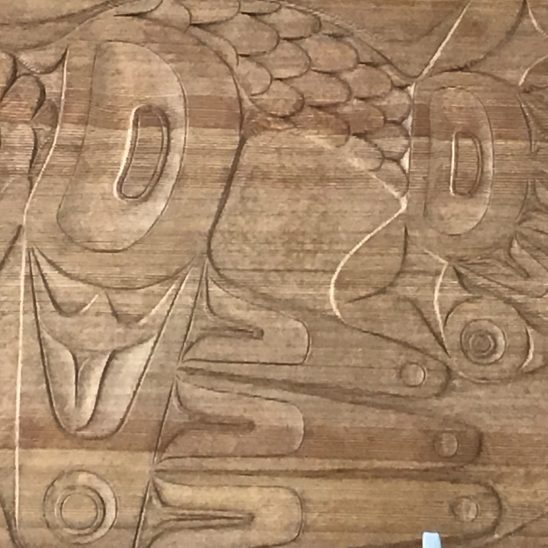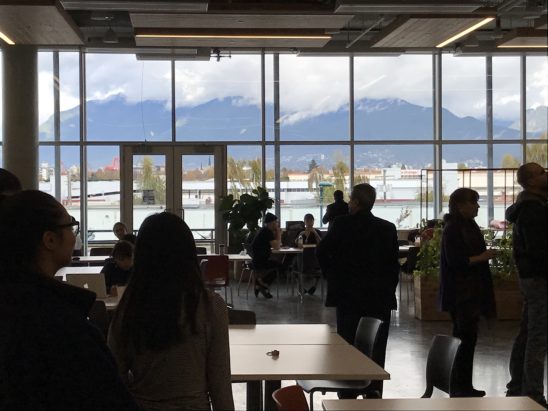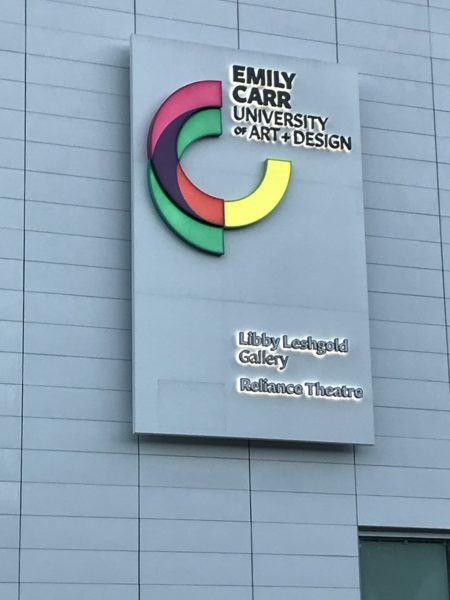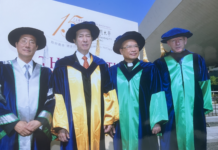I apologise for the lack of blog posts these last couple of months. I have been busy analysing and writing up data on course enrolments for the national survey. I’ve now more or less finished this and will now have more time for other things.
As a result, last Friday I attended one of my favourite annual workshops, the BC educational technology users’ group (ETUG) Fall Workshop on the new campus for the Emily Carr University of Art and Design. The theme for this workshop was ‘Just Share’.
There were several highlights from this workshop.
Acknowledging aboriginal title and culture
It is now almost standard at conferences in Canada to start with a formal acknowledgement that we are standing on the unceded territory of the relevant First Nation or Nations. While important, indeed, necessary, it sometimes feels a bit like a token ritual, without really addressing the issues of colonialism or really understanding aboriginal culture or needs.
In contrast, this workshop opened with a delightful welcome from Xwalacktun (Rick Harry), a distinguished Squamish artist and an alumnus of Emily Carr University. (If you have been to the wonderful Audain Art Museum in Whistler, the double doors were carved by Rick.) He also carved or finished some of the doors in the new Emily Carr University building (see photo).
He described the meaning of a Coast Salish ‘call-up’ dance, and using his drum, he ended up getting all the participants taking part in the dance, trying to be either eagles or wolves (which Rick found highly amusing). This was a great way to open the workshop.

The new Emily Carr University campus
The workshop also provided an opportunity to attend the wonderful new university campus on Great Northern Way, Vancouver, which opened in September.
The university was formerly located on Granville Island (it spawned a large number of the art and design studios now dotted across the island) but it was increasingly cramped and restricted by its small footprint, despite its great location. Its new campus is now next to the Centre for Digital Media, creating a nexus for art and design in the city.
Emily Carr University’s new campus has opened with the latest technology for virtual reality, has a centre for research into 3D printing in terms of materials and design, and workshops in ceramics, metalworking and other area fitted with the latest equipment and technologies, as well as also making use of more traditional tools and methods.

Moving to sustainable open education
The highlight though for me was Paul Stacey’s keynote. Paul has moved from his former job at Creative Commons to head up the Open Education Consortium. His keynote was on the importance of not just sharing, but being more nuanced about what sharing means. He feels that too much focus is given to licensing and content development, and not enough on collectively managing open resources so that they are sustainable and dynamic.
He had a term for this: commoning, which reflects the management and sustainability of common, shared resources and services. He pointed out that there are several different kinds of sharing:
- giving
- lending
- simultaneous use
- commoning, which entails collectively managing a shared resource so that it is sustainable (international fisheries might be one example)
It caused me to reflect on how I could do more to organise and sustain a ‘commons’ around my open textbook, ‘Teaching in a Digital Age’. At the moment, it is a ‘gift’. It is entirely up to other people how they use it.
How much more useful would it be to put the book into a pool of work by other authors or writers on the same or similar topics, and have a community to manage and sustain such works. This would facilitate the use of the book, enable the community to maintain its relevance by adding, changing, merging, or creating new content, and locating it within a wider body of work. Or maybe we already have a mechanism for doing this: it’s called a university, but we seem to have a lost our way a little with the ‘commons’ aspect of the academy.
Furthermore, with regard to my book, I have no idea how to do this and how realistic it is. But I think Paul is right in principle. Unless we find a better way of collectively managing open resources and services, they may end up being seen as a nice idea but not really pragmatic enough to survive on their own merit.
Other sessions
The workshop had an interesting format. The keynote was done as an interview between Clint Lalonde and Paul Stacey. It worked quite well, but depended heavily on Paul being able to stay focused on the main points he wanted to make.
This was followed by a whole string of 10 minute presentations, followed by a round of visiting tables where you could talk further with each presenter.
I did a quick 10 minute overview of the results (to date) from this year’s national survey (see my next blog post), and I found the round table discussion extremely valuable, as several workshop participants had been directly involved in collecting the data for the survey from their own institutions.
The other presentations varied widely. Rajiv Jhangiani gave a lightening tour of the H5P plug-in for WordPress, which enables authors to add activities for readers ranging from multiple choice questions to automated marking of essay type questions. I must follow up on this and see if it makes sense to introduce these into my open textbook. There were too many other lightning presentations to describe them all here .
Once again, the ETUG workshop was fun, enlightening and stimulating. It’s a real privilege to be part of this community.
Reference
Pearson, S. and Stacey, P. (2017) Made with Creative Commons Denmark: Ctrl+Alt+Delete Books: 24 in-depth examples of different ways to sustain what you do when you share your work.










 Dr. Tony Bates is the author of eleven books in the field of online learning and distance education. He has provided consulting services specializing in training in the planning and management of online learning and distance education, working with over 40 organizations in 25 countries. Tony is a Research Associate with Contact North | Contact Nord, Ontario’s Distance Education & Training Network.
Dr. Tony Bates is the author of eleven books in the field of online learning and distance education. He has provided consulting services specializing in training in the planning and management of online learning and distance education, working with over 40 organizations in 25 countries. Tony is a Research Associate with Contact North | Contact Nord, Ontario’s Distance Education & Training Network.


Hi Tony curating Open Education looks similar to Wikipedia but with semantic structures to give form to knowledge development.
A great tool for this might be oceanbrowser. Media can be four dimensional.
Also I am glad you mentioned H5P, it is a game changer for active learning design. Robert
Thanks, Robert – I’ll check out oceanbrowser.